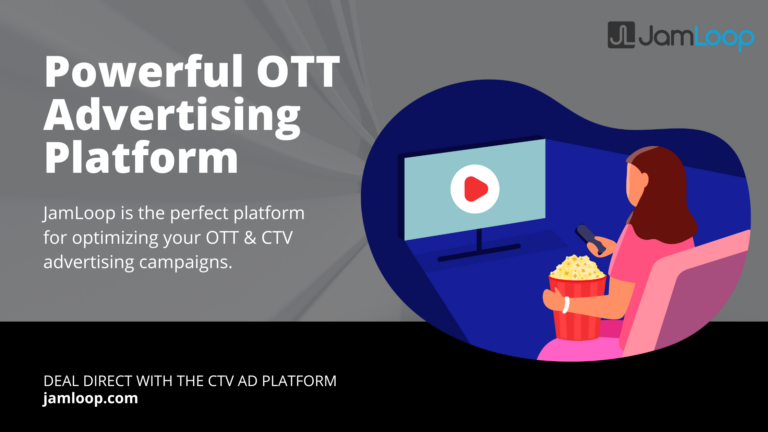
The way that we consume media has changed significantly over the last decade, with streaming services on the rise and cord-cutting — dropping your cable or satellite subscription in favor of streaming — becoming the norm for TV viewers nationwide. There are also a lot of people who have never had a subscription to cable or satellite TV; they prefer the price and convenience of streaming media. Combined, this can take away a large portion of a brand’s target demographics, leaving them unable to reach these people through cable anymore.
There has been an increase in the over-the-top (OTT) streaming services available in the last few years in response to this. With this rise in viewership and the decline of traditional TV, marketing has had to make a shift itself with OTT advertising.
OTT Advertising Defined
The term “Over-the-Top” refers to streaming services going over the heads of (essentially bypassing) traditional TV providers’ cable set-top boxes. People love the convenience of using OTT services because the content is available on demand — there is no schedule, so you can watch your show at any time instead of missing an episode because you were not home when it aired. The convenience of being able to watch TV anywhere and on any digital device, from your TV to your phone, is also a large part of the reason for the popularity of OTT media.
OTT advertising is advertising that appears within content on these streaming services. The commercials you see when you are watching something on Philo or Hulu or Crackle are OTT ads. OTT advertising is different from advertising on traditional TV for a few reasons: First, the ads need to be viewable across multiple screens, big and small alike, from smartphones and tablets to laptops or 60-inch TVs. Second, you can target viewers at a much more granular level than traditional TV (e.g. vary the ads by household or by device), allowing you to get more out of your advertising budget than you do on traditional TV. Third, while all of the major TV networks now have a presence on streaming apps, there are also many smaller niche, digital-only streaming services emerging; you can design your OTT ads to match the audiences of those niche services.
Why OTT Advertising is on the Rise
Targeting Capabilities
Having the ability to target your audience so precisely with your ads is one of the most appealing parts of using OTT advertising. You can target your audience based on demographics, geographical information, and more; using an OTT advertising platform gives you access to more in-depth information than you might get by buying your OTT ads through publishers individually. While not everyone who sees your ads is going to buy your products, you are still reaching people who you might not otherwise reach on traditional TV, and doing so with pinpoint messaging.
Measurement & Analytics
OTT advertising offers reporting analytics that far surpasses traditional TV advertising. You can track your OTT ad campaigns’ progress and success with ease, and you can get a detailed analysis of how your campaigns performed overall. Do you want defendable metrics for audience reach and frequency? Do you want to know how many people saw your ad and visited your website or retail store? You can measure that for every ad impression delivered. This kind of insight alone can make OTT ads worthwhile for any brand.
Multichannel Campaign Targeting
Another great benefit to OTT advertising is that you can use re-targeting campaigns, so the ads consumers see while streaming TV shows pop up later on, for example, their smartphones when they are on the go, providing multiple consumer touchpoints and reinforcing the overall brand messaging.
Lower Cost of Entry
While traditional TV advertising prices vary from market to market, OTT advertising tends to be more price efficient when taking into account all the parameters typically used to reach a target audience, i.e. geo-targeting, demo targeting, interest targeting, etc. because there is little ‘waste’ associated with reaching non-targeted audiences like in traditional TV advertising. In addition, the monthly budget commitments are typically much lower for placing OTT ads than traditional TV ads, allowing more small businesses to experiment with and optimize their TV messaging in ways they have historically not been able to do.
OTT Advertising Best Practices
If you plan to invest in OTT advertising, there are some best practices to keep in mind.
Keep Them Short
Make your ads short and sweet; if you do not want to sit through a minute-long ad, your audience probably does not want to either. Anything longer than 30 seconds and attention will wander quickly; 15 seconds or shorter is ideal for advertising on mobile devices.
Make the ads Relevant and Watch the Formatting
Since you can tailor your ads to your audience with OTT’s targeting capabilities, take the time to make your ads more relevant to them. You can also have multiple campaigns running for different segments of your audience, all of which can be tailored by the OTT advertising platform you choose to work with. Your ads’ formatting is essential, since they need to be usable on any device, so keep that in mind when designing your ads.
Conclusion
As a marketer, investing in OTT advertising is a sound business decision that will help you reach more of your audience for less money in a metrics-driven manner. Since OTT advertising is still relatively new, many of your competitors may not yet have a presence on streaming platforms, giving you a unique opportunity to build brand awareness and a high share of voice for your local cord-cutting audiences. Take advantage!
It is easy to get started
Send us an RFP, and your dedicated JamLoop account manager won't skip a beat. We'll get right back to you with a customized media plan.





